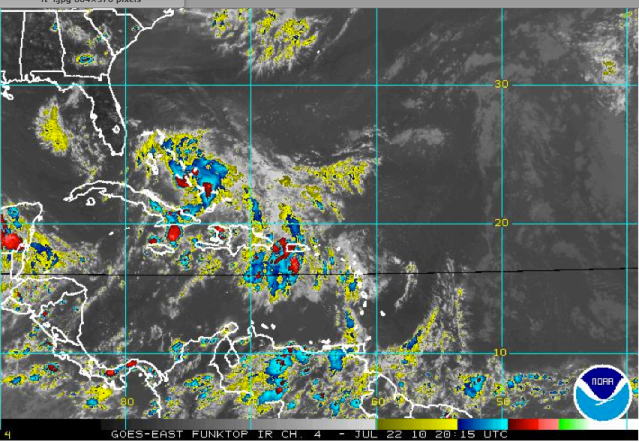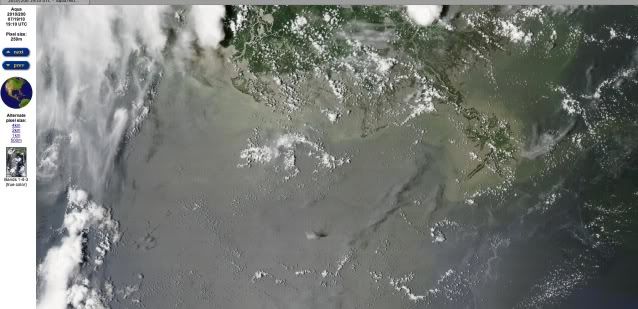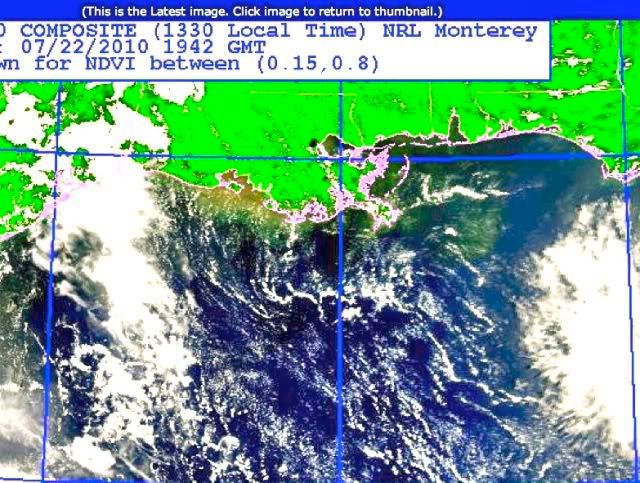( – promoted by buhdydharma )
For the past several days, everyone has been speculating on what would be done with the unfinished relief wells and new but ever so slightly oozing sealing cap and 3 ram stack assembly, should the relatively calm Gulf coast weather turn on them. Today’s the one week anniversary of the BP oil well successfully being turned off.
Previously no decision had been made, with hints that the well might have to be opened up again, if they had to abandon the Macondo Canyon 252 site because of a hurricane or tropical cyclone.
Per Admiral Thad Allen’s latest press briefing this afternoon, ongoing, they are planning to leave the broken BP oil well capped if they have to evacuate the area because of an oncoming weather system.
http://twitter.com/BP_America/…
The relief well that is farther along, and only about 4 feet horizontally from intersecting the old Deepwater Horizon wellbore, with just a bit of casing to put in at the very end for the last 100 feet they still have to drill, has received a temporary plug, called a “storm packer ” which they stuff down it 300 feet below the sea floor.
Picture of the storm packer plug here: http://www.theoildrum.com/node…

Tropical Depression #3, not looking real organized yet.
Here’s the storm that will be named “Bonnie” if it gets organized. Right now, Bonnie is still Tropical Depression #3 with a “high” aka 50% or greater, probability of going to cyclone status within 48 hours, and a projected storm track to head possibly for the Louisiana Delta. T.D. #3 is over land right now, which is keeping it milder. http://www.nhc.noaa.gov/gtwo_a…
Here’s a live, updating, easy to load satellite link to watch “Bonnie to Be” which is currently the leading edges on the very right hand side of this image, Thurs, July 22, at 1:35 pm PDT. ( pic was taken 2:45 pm local )
http://www.ssd.noaa.gov/goes/e…
Here’s that NOAA cafeteria page of every possible weather graphic you’d ever want to see for New Orleans/Baton Rouge, loads more slowly http://www.srh.noaa.gov/lix/?n…
Time to batten down the hatches and boogie on out for a spell:
BP’s Kent Wells on Wednesday: download of pdf of BP technical briefing
http://www.bp.com/liveassets/b…“forecasts have all been made can put some probability that you could have tropical force storm winds hit the Macondo site within a certain period of time, and we have to plan all of our operations around that. We have to have the ability to get out of the way if that were to happen…. ”
“We’re still seeing the pressure continue to build slowly. Last time I checked it was about 6850 psi….Continuing on that trend, we would expect all of the monitoring that we’re doing, continues to build our confidence that the well has integrity, we have no evidence at this point that the well doesn’t have integrity, hasn’t guaranteed it yet, but it just continues to build on that”
He also said yesterday that “we still do not have approval to do the static kill so we need to keep that in mind.”
Static kill is what they are calling the next “top kill” effort whereby they would pump drill mud into the existing well again while leaving it capped and closed with the new cap ‘n stack. He also claimed that the static kill preparations “in no way slows down the relief well activity” and it supposedly “accelerates the final killing of the well. ” And it becomes clear after reading the pdf, that at that moment in time, BP was determined to do this “static kill” procedure before drilling into the existing well bore, as a new condition of doing the final part of the relief well. Or somebody was. And static kill cannot happen without the casing and cement being set in the bottom of the nearby relief well. Because they are close.
And they need more time, because they’ve pulled everybody who was making noise overhead back the last week to listen for leaks, sonor, seismic, acoustics, pinging, the ghost of Truman Capote, whatever.
I heard someone on the Oil Drum complaining that the had trouble understanding Adm. Allen. No, you haven’t tried parsing Kent Wells off his teleprompter. Adm. Allen is easy.
Thank God this was a transcript:
The question was, how long of a weather window do you need ?
Kent Wells answering question: “I’m not familiar with that last statement at all, but on terms of the weather window, as I’ve sort of mentioned, we you to know probably somewhere, anywhere in the range of two to four days to get the casing in the bottom and get it cemented and let’s call it a day for the static kill. So we’re looking in- we need at least that range, but then we also must have the ability that if once we start the operation and I’m thinking now strictly of the relief well, that we would also have the ability to then – still have the ability to disconnect and get out of the way if a storm would come. So we always look at these weather windows as – you know we’re sort of looking for – a week would be ideal for us to get back to work. ”
Meanwhile, for all those people floating around out there:
http://ht.ly/2fd5f 7/22/10 13:18 pm CSTRr Adm Paul Zunkunft
“We are repositioning assets away from low-lying areas to higher ground staging areas to protect our ability to respond to the dynamic requirements of the incident. The protection of the equipment and crew is paramount to ensure maximum ability to respond to any new challenges a storm may pose to the enormous mission. We are committed to following through with our response. There will be no reductions in effort, urgency or commitment even as we sustain the long-term relief effort,” said Zukunft.
Activities that are underway for storm preparedness include evacuating specialized vessels from the path of any severe weather to prevent damage and ensure that oil recovery operations can resume as soon as possible after a storm. Additionally, boom is being removed from marsh areas where oil is not threatening the shore to prevent damage from the heavy equipment getting pushed into the delicate area by strong winds and high tides.
So that’s where we’re at. They’re going to break down the floating City of Ships (I like to think of it as the Cheney Carnival Cruise from Hell ) , take a week off, and see what Mother Nature does with the oil slick.
A sequence of what the area in the Gulf of Mexico looks like, from screen captures of satellite pictures this week:
today, Thurs 7/22/2010, 1 week capped on BP well. Oil still in water is greenish brown and black, grey on the farthest left under clouds, water blue, shoreline pink, clouds white, vegetation green. Louisiana delta. photo NRL Monterey, biomass, which has been lightened to show the oil.

Above, day 4 of the well being capped, 7/19/10 Monday. Louisiana Delta. Natural color, photo NASA rapid response. Few strands of the freshest oil are silvery on the left SE of the Mississippi River Delta. Much of the mass of oil is the grey tannish sludge to the left, the west.
*
*
Sunday, day 3 of the well being capped, 7/18/2010. Natural color. Shoreline Gulf of Mexico, west of the Louisiana Mississippi River delta. A lot of the older oil sheen has blown northwest again from the Franklin eddy in the middle of the Gulf , where it had been swirling around, up towards Louisiana and Texas. Finer resolutions and a larger view of this picture may be seen at the NASA rapid response site catalogue for this day. The dark swirls on the right are blue water peeking through the mess. The oldest oil in the water is the greenish brown junk along the coast on the right hand side.
Okay, it’s just a coincidence this operation “well endgame” times out with the Senate’s last week in session before August break, right ?



2 comments
Author
…. special.
We now watch them pause for refreshments, and pray that Mother Nature performs some of that natural bio remediation.
Now let’s see who picks it up.